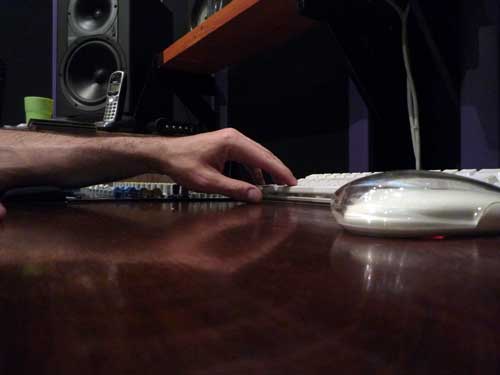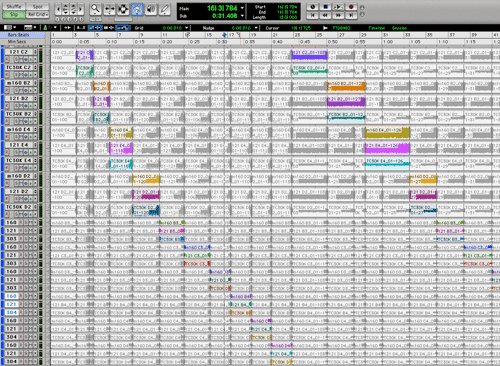|
04.19.10
Element 4 - Guitar, direct
Microphone placement is the most important part of recording the electric guitar. Once the person playing has decided on the sound that they like, investigating playing styles, guitar/pickups, effects pedals, amps and settings (and all the stuff in between), the starting point of recording should be to best represent that sound on tape. For this reason, I'm irritated by the sound of an amp modeler but also appreciate that the mix/preamp/placement selection will be different depending on what's happening before the sound leaves the amp cabinet's speaker.
An overdriven electrical guitar (normally called 'distorted') has a lot of sonic information spread over a wide section of the frequency spectrum. Therefore, small position changes in the microphone will end up providing the most upfront emphasis or cancellation to different parts of the sound. Again, the comparison to jacking up/dropping different sliders on a graphic EQ is appropriate. We want to find a place for the mic that does a lot of things - provide clarity between individual notes, retain the impression of physical impact of the amp blaring in the room, giving the right level of chaotic noise that comes from playing through 3 distortion pedals and an overdriving Marshall head.
Real quick before we get into it - I notice that, when this is not done well, the guitar either sounds weak or it's fatiguing to listen to over time. The weak part can be worked around but the fatiguing part is troubling. I really think that the brain retains this information and associates hearing those recordings (and those songs) with something that is grating, thereby making the lister liking it less and less over time. This effect is due, I think, to an overemphasis on a particular part of the frequency range. In more simple terms: no matter how great the riff, if the guitar playing it always sounds like it's coming through a nuclear powered telephone speaker, the song (or record) will not be loved as it should be.
Mic Placement
The two microphones on the HF cabinet get the same approach as the bass did - we taped a grid of 2cm x 2cm boxes to the floor and moved both mic stands in conjunction over the grid. (LF mic stayed hovering over the center of the LF speaker, only about 1/2" or so off the cabinet. As noted before, the differences in sound were very, very minor with this, so best just to go for a simple placement and then forget it.) We decided it was best to move them together, as there are no end to the combinations of possible placement areas if we mixed and matched. To give ourselves a sense of the range, we started at square A1 (mic up against grill and centered over cone) and then did A4 (6 cm back), then A7 (6 cm more). Then we moved over to E1 (8 cm over), E4, etc all the way to I7. E4 sounded best and so we created a finer set of adjustments, which we've got here.
CHOICES - (HF guitar cabinet only)
1. C2 (4 cm off-center of cone, 2 cm back from grill)
2. B2 (2 cm off-center of cone, 2 cm back)
3. E4 (etc.)
4. D2
5. B3
6. C3
7. D3
8. C4
9. D4
RESULTS
And yet again, two versions: one with the guitar soloed and one blended into the rest of the stuff.
Guitar - 9 way placement comparison for HF cabinet mic - solo.
Guitar - 9 way placement comparison for HF cabinet mic - full.
As with most of the stuff we've been paying attention to lately, the real difference here comes in the high frequency presentation. This isn't surprising when you consider the much shorter physical wavelength of a 15 khz tone vs. a 150 hz tone. Moving a mic 4 cm isn't going to make a difference in how you hear the 150hz tone, but it's considerable how different that 15hz tone is going to sound.
(If I understand the math on this right, sound moves at somewhere around 1000 feet per second, which is a fine enough approximation for this. A sound wave that repeats once per second, then, would have a wavelength of 1000 feet - 3 and 1/3 football fields long. That 150 hz tone represents a sine wave about 80 inches long; you'd need to move a microphone over 3 feet to catch that signal at the opposite point in its wave cycle. The 15 khz tone, on the other hand, represents a wavelength about .8 inches long, meaning it's at the opposite point of its cycle less than 1/2 an inch away. I'm just sort of piecing this together from what I know, so please e-mail me if I'm bananas on this.)
The differences are best evaluated during the second guitar part when the strumming becomes faster and at one octave up. Here the effect of the boost and cuts in frequencies plays out between what pops through and the impression it gives the listener. For me, the key part is to bring out the main note, catch a bit of the action of the strumming and also catch some of the droning, secondary sounds.
This brought me nearly there. I then took my favorite spot - position 9; D4 (6 cm back, 6 cm off center from grill). From here I new I generally liked about the bass impact I was getting, so I just needed to check out side to side to see if I prefered the treble presentation.
CHOICES, 2 - (HF guitar cabinet only)
1. C4
2. D4
3. E4
RESULTS
Guitar - 3 way placement comparison for HF cabinet mic - solo.
Guitar - 3 way placement comparison for HF cabinet mic - full.
3 ends up sounding a little hollow. I'd like to generally mix between 1 and 2, maybe to dampen a small bit of the attack for the highest notes.
DECISION AND NEXT STEPS
Both the Royer 121 and beyer M160 will sit 6 cm back, 5 cm off center axis of the speaker cone center. The Earthworks TC30K is on the LF cabinet, centered above the middle of cone and less than 1/4" back from the grill.
Whew. That was a lot of work. Next up is the vocals. Easier to pick the preamp (we've already got it in mind) buy we now have to compress the resulting signal to make sure the vocals sit well in the music.
|
|  |
 |
 |



I guess I keep including these images for two reasons. First, they are instructive if you want to set up this type of comparison. Second, they are also pretty ridiculous.

|
 |
 |
 |
[ LATEST UPDATE ]
[ Archives ]
CONSTRUCTION
[ Overview ]
[ Basic Construction ]
[ Acoustics ]
[ HVAC ]
[ Electrical ]
[ The Grand Vision ]
[ Tool Reviews ]
[ Links and Resources ]
|